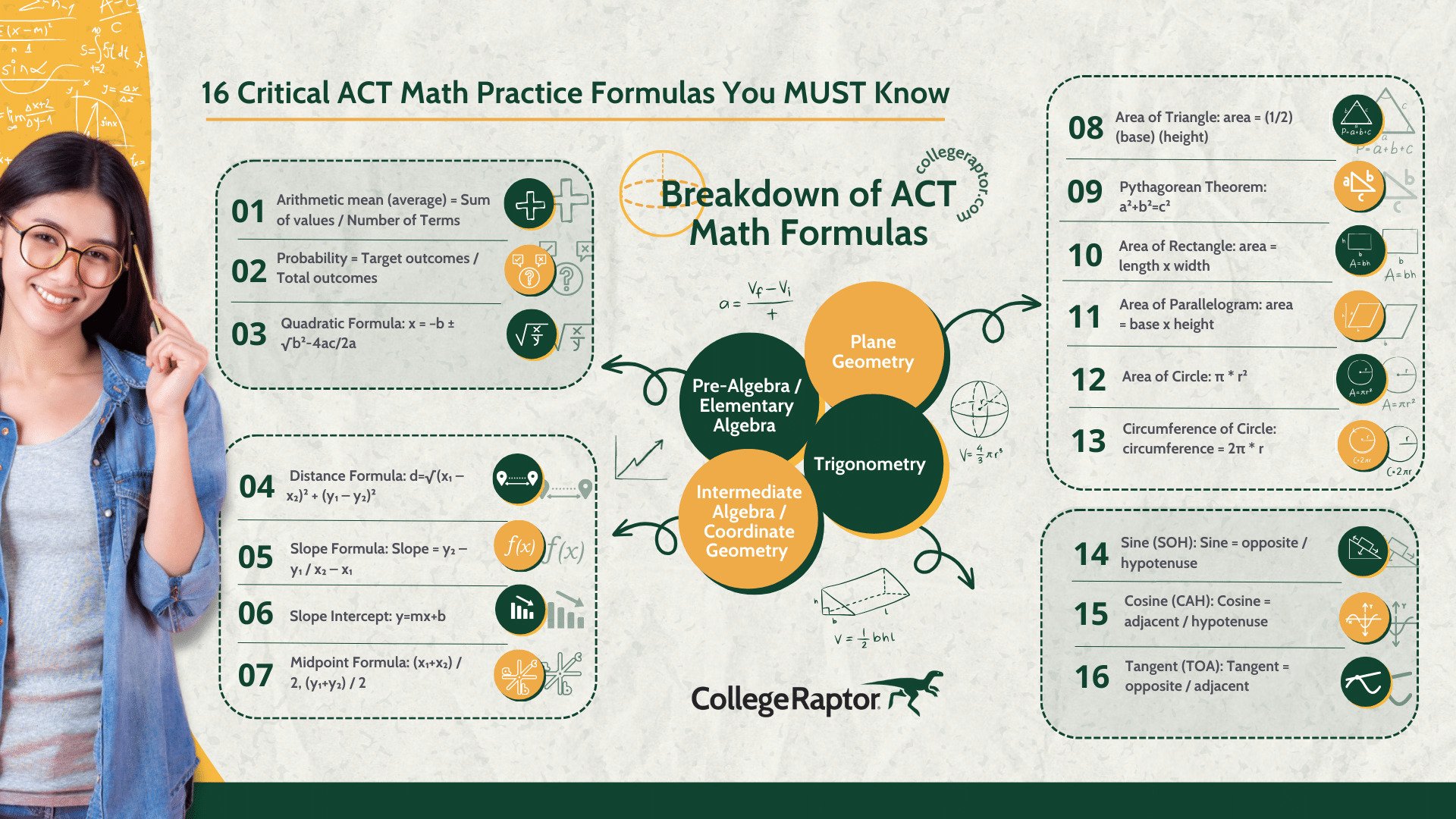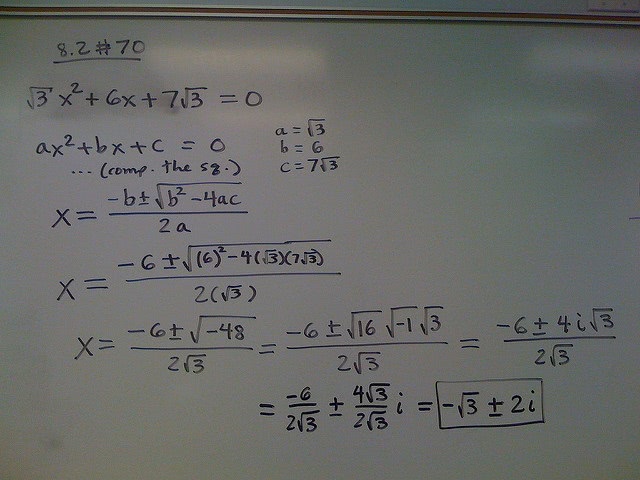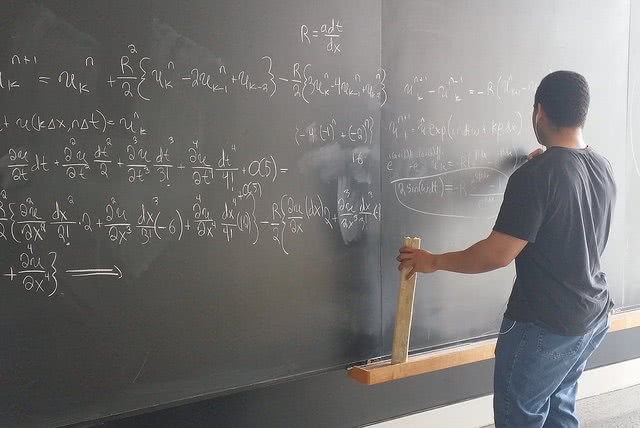Do you really need to memorize ACT math formulas? As daunting as it seems, memorizing the math formulas for ACT is essential. The ACT doesn’t give you a math formulas sheet, which means you’ll have nothing to refer to when solving the math problems on the test.
Adding to the challenge is the fact that you get only 60 minutes to answer 60 questions – that’s one minute per question. The best way to speed through the questions and answer them all correctly within the time frame is by memorizing important math formulas for ACT.
Breakdown of ACT Math Formulas
Breaking down exactly what the Math section consists of can help you get a better idea of what ACT math formulas you need to remember. There are 60 total multiple-choice questions taken from six areas of your high school math: pre-algebra, elementary algebra, intermediate algebra, coordinate geometry, plane geometry, and trigonometry.
The scoring and what math formulas you need to know breaks down like this:
- Pre-Algebra / Elementary Algebra: 24 Questions, 24 Points
- Intermediate Algebra / Coordinate Geometry: 18 Questions, 24 Points
- Plane Geometry / Trigonometry: 18 Questions, 24 Points
We’ve put together a list of the most critical ACT math formulas that you should memorize as part of your test prep. You’ll encounter these more frequently than others on the test paper. Each of the math formulas for ACT is accompanied by a quick explanation of what it means and how to use it.
Here’s a list of the most important formulas in each section.
Pre-Algebra / Elementary Algebra
These algebra formulas involve basic math and algebra. In other words, it requires the student to solve for an unknown variable.
1. Arithmetic mean (average) = Sum of values / Number of Terms
This is specifically used to calculate the mean or average value of a given set of numbers. In arithmetic, ‘mean’ and ‘average’ mean the same thing.
For example: Find the average of 10, 12, 14, 16:
Solution: (10 + 12 + 14 + 16) / 4 = 13
2. Probability = Target outcomes / Total outcomes
This formula is specifically used to calculate the chances of something occurring from a set of possible outcomes.
For example: A jar contains five blue marbles, five red marbles, and ten white marbles. What is the probability of picking a red marble at random?
Solution: 5 / 20 = .25 or 25%
3. Quadratic Formula: x = −b ± √b²-4ac/2a
A quadratic formula is specifically used for determining the x-intercepts of a quadratic (parabolic) equation.
For example: A = 1, B = 4, C = 4, what is the value of x?
- x = -4 ± √4² – 4 (1)(4) / 2(1)
- x = -4 ± √ 16 – 4(4) / 2
- x = -4 ± √16 – 16 / 2
- x = -4 ± √ 0 / 2
- x = -4 / 2
- x = -2
Intermediate Algebra / Coordinate Geometry
The ACT math formulas under this section are used to calculate distances, lengths, and properties of points on a plane. They also solve for variables in more complex algebraic expressions.
There will be at least five to six questions on linear equations and functions on every ACT test, so this is a very important section to know.
4. Distance Formula: d=√(x₁ – x₂)² + (y₁ – y₂)²
This formular is used to calculate the distance between two points on a coordinate plane.
For example: Find the distance between points (6, 6) and (2, 3) on a coordinate plane.
- d=√(6 – 2)² + (6 – 3)²
- d=√(4)² + (3)²
- d=√16 + 9
- d=√25
- d = 5
5. Slope Formula: Slope = y₂ – y₁ / x₂ – x₁
You need to use this formula to calculate the slope (angle) of a line that connects two points on a plane.
For example: Find the slope of the line that connects the slope coordinates at (-2, -1) (4, 3).
- s = 3 – (-1) / 4 – (-2)
- s = 4 / 6
- s = 2 / 3
6. Slope Intercept: y=mx+b
The slope intercept formula defines a line on a plane, given a known slope and y-intercept. The y-intercept refers to the point of the line that crosses the y-axis.
For example: Find the slope intercept (y) when the slope = 2 and Intercept point is 0,3
- y = 2x+3
7. Midpoint Formula: (x₁+x₂) / 2, (y₁+y₂) / 2
The midpoint formula specifically calculates the midpoint between two points on a single plane.
For example: Find the midpoint between the two points at (-1, 2) and (3, – 6)
- Midpoint = (-1 + 3) / 2, (2 + -6) / 2
- Midpoint = 2 / 2, -4 / 2
- Midpoint (1, -2)
Plane Geometry
This ACT math formula section includes formulas for calculating attributes of geometric shapes within a plane and solving for variables based on the angles of a given shape (trigonometric identities).
8. Area of Triangle: area = (1/2) (base) (height)
You’ll need to use this to specifically calculate the total area within a triangle based on the measurements of the lengths of the sides.
For example: Calculate the area of a triangle if its Base = 5 and Height = 8.
- a = 1/2 (5)(8)
- a = 1/2 (40)
- a = 20
In a right-angled triangle, the height of the triangle will be the same as any one side of the 90-degree angle.
If the triangle is not right-angled, the height will be measured from the topmost vertex to the midpoint on the base of the triangle.
9. Pythagorean Theorem: a²+b²=c²
The Pythagorean theorem is used specifically to calculate the length of an unknown side of a right triangle when two sides are known.
For example: Find the length of the c² (unknown side) when a = 3, b = 4
- c² = 3² + 4²
- c² = 9 + 16
- c² = 25
- c = √25
- c = 5
10. Area of Rectangle: area = length x width
This is a simple and straightforward way to calculate the total area within a rectangle shape.
For example: What is the area of a rectangle if its length = 5 and width = 2.
- a = 5 x 2
- a = 10
To calculate perimeter of the same rectangle, you add the measurements of the four sides.
The formula would be: Perimeter = length + width
11. Area of Parallelogram: area = base x height
This formula is used to specifically calculate the total area within a parallelogram.
For example: Calculate the area of a parallelogram with a base = 6, height = 12
- a = 6 x 12
- a = 72
12. Area of Circle: π * r²
You’ll use this formula to calculate the total area within a circle. π has a constant value of 3.14 and is always used when calculating the area of any circle.
For example: Calculate the area of a circle with a radius of 4
- a = π x 4²
- a = π x 16
- a = 50.24
If the problem on the test paper provides the diameter of the circle and asks you to calculate the area, you have to first divide the diameter by 2 to get the radius. This is because the radius of a circle is half the diameter. Use the value of the radius to calculate the circle area using the formula a = π x 4².
13. Circumference of Circle: circumference = 2π * r
The circumference formula is used to specifically calculate the total length of the outline of a circle. As before, π is a constant and has a value of 3.14.
For example: Calculate the circumference of a circle with a radius = 7
- c = 2π x 7
- c = 2 x 3.14 x 7
- c = 43.96
Let’s say, instead of the radius, the problem provides the diameter of the circle and asks you to calculate the circumference. In this case, you can directly use the formula π x d (diameter). This is because 2 x radius = diameter.
Trigonometry
The trigonometry section continues from the previous plane geometry section. When you look though the test paper, you’ll see that almost all trigonometry formulas for ACT can be clubbed into a few basic concepts. Before you continue, it’s important to understand these basic concepts and terms:
- SOH: Sine equals Opposite over Hypotenuse
- CAH: Cosine equals Adjacent over Hypotenuse
- TOA: Tangent equals Opposite over Adjacent
Sine, cosine, and tangent refer to three types of graph functions. In all three ACT math formulas below, the adjacent side refers to the side of the triangle that is nearest to the angle in question but is not the hypotenuse. The hypotenuse is the longest side of a right-angled triangle.
14. Sine (SOH): Sine = opposite / hypotenuse
This is a trigonometric identity that represents the relative measurements of the sides of a triangle. It can also be used to calculate unknown sides or angles of the triangle.
For example: Find the sine if the length of the side directly opposite the angle = 2.8 and the hypotenuse = 4.9
- s = 2.8 / 4.9
- s = 0.57
15. Cosine (CAH): Cosine = adjacent / hypotenuse
Cosine is a trigonometric identity that represents the relative sizes of the sides of a triangle and can also be used to calculate unknown sides or angles of the triangle.
For example: Calculate the cosine when the adjacent side of the triangle = 11 and the hypotenuse = 13
- c = 11 / 13
- c = 0.85
16. Tangent (TOA): Tangent = opposite / adjacent
Tangent is a trigonometric identity that represents the relative sizes of the sides of a triangle and can also be used to calculate unknown sides or angles of the triangle.
For example: Calculate the tangent if the opposite side = 15 and adjacent side = 8
- t = 15 / 8
- t = 1.87
Two formulas that are useful to know regarding sine, cos, and tan are:
- Sin2 + Cos2 = 1
- Sin ÷ Cos = Tan
Are There More Math Formulas for ACT?
Yes, there are other math ACT formulas that you’ll encounter on your test paper but the ones listed above are the most common. That makes them the most critical to know. Memorize these math formulas for ACT, study, practice, and you’ll be just fine come test day.
If you start doing this much before your test date, you won’t need to stay up all night cramming the few days prior to the schedule test date. Use those last few days before the test to relax, confident in the fact that you’ve memorized the most critical math ACT formulas and are as ready as you’re going to be.
READ NEXT >> How To Do Better In Math: 7 Tips – College Raptor Blog
Good luck!
Check how your ACT scores affect your acceptance odds with College Raptor!






